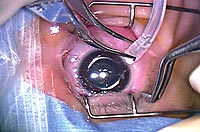25-gauge vitreoretinal surgery benefits pediatric patients
Smaller instruments have been advantageous in vitrectomies for various causes, including retinopathy of prematurity, surgeon says.
Click Here to Manage Email Alerts
Using smaller instruments during vitreoretinal surgery may be advantageous for pediatric patients, according to a surgeon.
 |
Despite limited literature on 25-gauge instruments in the pediatric population, Steven D. Schwartz, MD, said in addition to potential advantages shown in adults, such as more rapid healing, improved patient comfort and less surgical trauma, the reduced size of the instruments seemed to be conducive to the smaller eyes of children.
“25-gauge vitrectomy may have distinct advantages, we feel, in the pediatric populations,” he said. “Based on our experience, there does not seem to be an increased risk of 25-gauge surgery in the children.”
Advantages
At Retina 2008, held in conjunction with Hawaiian Eye 2008, Dr. Schwartz said the introduction of 25-gauge instruments also allows a more controlled procedure.
 Image shows pars plicata vitrectomy with 25-gauge instrumentation in a pediatric eye. Note the location of the sclerotomy. Image: Schwartz SD | ||
Previously, when using traditional 20-gauge instruments, he was performing a two-port retinopathy of prematurity (ROP) surgery. With this procedure, “no matter how careful you were, there was a moment of hypotony, and IOP was difficult to control,” he said.
With these instruments, particularly the latest versions with more structure, Dr. Schwartz said he could perform three-port ROP surgery.
“There were some other advantages in the pediatric eyes, and one of the big advantages is that smaller instruments work better in smaller eyes, [but] particularly the new-generation stiffer instruments function really nicely,” he said. “The three-port system has an obvious advantage in improved control of the IOP.”
Potential risks
The sutureless techniques commonly used with 25-gauge instruments could potentially be a problem for pediatric patients, Dr. Schwartz said.
In particular, premature infants may be at a risk because of the potential for hypotony, bleeding in vasoproliferative diseases and the likelihood of rubbing their eyes postoperatively.
“We were really worried about postop bleeds,” he said. “In ROP, bleeding can be catastrophic and should be cautiously avoided. I realize it sounds like an oversimplification, but control of intraocular hemorrhage in the pediatric vitreoretinal surgery population is an imperative, it’s a lot different than managing vitreous hemorrhage in adults.”
In addition, Dr. Schwartz said the potential risks of an undeveloped pars plana, as well as the need for anterior pars plicata incisions and adequate coverage of sclerotomies, pushed the physicians to modify their pediatric 25-gauge technique.
Modifications
Dr. Schwartz and colleagues have also modified the 25-gauge vitrectomy procedure to further ensure pediatric safety.
Christine A. Gonzales, MD, opens the conjunctiva to cover the sclerotomies and uses a 22-gauge needle to create a track for the 25-gauge instruments, Dr. Schwartz said.
“I can tell you that the eyes she operates on are fairly quiet. She’s getting beautiful results,” he said.
Dr. Schwartz said an additional advantage of the needle is the increased size of the incision site, allowing a larger fulcrum and more movement, which was more important before the latest-generation of stiffer instruments.
Another modification used when the pathology is situated anteriorly in the eye is to trim the cannula or to not use one at all, he said.
Retrospective study
Dr. Schwartz presented a retro-spective study conducted at the Jules Stein Eye Institute, University of California, Los Angeles, in which he and colleagues performed a 5-year chart review of consecutive patients younger than 18 years.
All cases underwent 25-gauge pars plana vitrectomy for various indications, he said. The study included 56 eyes of 49 children who averaged 4.5 years of age, ranging from 2 months to 17 years. Follow-up ranged from 10 days to 4.2 years, with mean follow-up of about 8 months.
Dr. Schwartz said 29 eyes (52%) underwent the modified 25-gauge technique, and 26 eyes (46%) underwent the three-port approach.
Surgery was indicated for a variety of reasons, ranging from endophthalmitis and macular hole to cataract and vitreous hemorrhage, but the most common reason was ROP in 26 eyes. Forty eyes (71%) had no prior surgery, while 16 had prior intraocular surgery, he said.
The anatomic goal was achieved in 75% of eyes. It was not achieved in 16% of eyes, and 9% did not have sufficient follow-up to determine whether success was achieved, Dr. Schwartz said.
He concluded that 25-gauge vitrectomy has distinct advantages for pediatric patients, and there did not seem to be an increased risk.
Complications
Seven cases had intraoperative complications and had to be converted to 20-gauge vitrectomy. These included suspected lens damage and bleeding, but there were no cases of retinal tears or detachments. Importantly, none of the eyes developed endophthalmitis, Dr. Schwartz said.
Postoperatively, he said five eyes developed cataracts, four had rhegmatogenous retinal detachment and three had vitreous hemorrhage.
“You should know [the retinal detachments] are all with complex pathology, so it’s hard to determine if the etiology stems from the pathology or the surgical technique, but we want to list everything here,” he said.
Dr. Schwartz also questioned whether this study missed any postoperative complications because of the short follow-up.
All of the vitreous hemorrhages, cataracts and retinal detachments occurred within 3 months after surgery, and no major complications occurred in the additional follow-up time, Dr. Schwartz said.
At a tertiary practice, although, he said it is difficult to have long-term follow-up and definitively link complications to the surgery.
For more information:
- Steven D. Schwartz, MD, can be reached at Jules Stein Eye Institute, University of California, Los Angeles, 100 Stein Plaza, Los Angeles, CA 90095; 310-206-7474; fax: 310-825-3350; e-mail: schwartz@jsei.ucla.edu.
- Katrina Altersitz is Managing Editor of Ocular Surgery News Latin America and India Editions.
